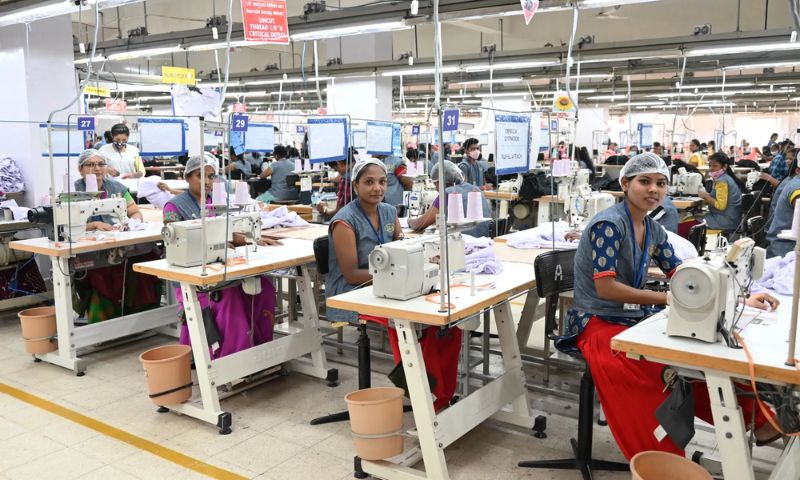Key points
- US tariffs on Indian goods doubling to 50pc, hitting key sectors hard
- Carpet industry alone risks 2.5 million jobs in North India
- Pharma and electronics currently exempt but face future threats
- Modi urges self-reliance as government support remains limited
ISLAMABAD: New US taxes on American imports, even at 25 per cent, will hurt many Indian businesses and may put vast numbers of people out of work.
A big part of India’s economy is facing a nightmare scenario. On August 27, the extraordinarily high tariff of 25 per cent that President Trump imposed on its exports to the United States is set to double. Businesses that were viable are bound to go bust quickly as orders dry up, according to a report published by The New York Times.
“We were shocked with the 25 per cent tariff, and thinking about how to meet this problem, how to face this,” said Ishtiaq Ahmad Khan, a fourth-generation carpet maker in Bhadohi, in the giant state of Uttar Pradesh. “But now it’s 50 per cent, so it became impossible. We’re afraid that a lot of people will be unemployed.”
READ ALSO: One Hundred Thousand Indian Jobs Lost in Indian Diamond Industry due to Higher US Tariffs
Carpetmaking is a big business in India, with 98 per cent of the product shipped overseas. Hand-tufted carpets form the bulk of the trade, whereas Persian-style hand-knotted rugs are the most valuable. In recent years nearly 60 per cent of that stock has gone to buyers in the United States. For American importers, that $500 rug now comes with a $125 tariff and possibly a $250 one.
India’s carpet belt
According to The New York Times report, Bhadohi is at the heart of north India’s carpet belt, home to hundreds or thousands of manufacturers like Ishtiaq’s company, Ajaz Carpets. They eke out their profits, so they do not have the means to absorb the giant price increases their American customers now face. Ishtiaq, who led the industry’s trade promotion council, estimates that 2.5 million people who live in the region could be plunged into subsistence-level poverty.
Other industries in line to face unbearable wipeouts include textiles and garments, aquaculture — mainly farmed shrimp — and furniture. They are not India’s flashiest businesses, but together they employ many millions of workers, and the billions they earn have helped keep India financially strong during periods of crisis.
Carpets are nowhere near the highest-value component of the India-US trade in goods, which was worth $129 billion last year. But for now, questions about the even bigger, more strategic parts of the two countries’ trading relationship have been postponed.
Generic pharmaceuticals
India is the primary producer of generic pharmaceuticals used in the United States, for instance, and the United States is that industry’s biggest consumer market. But a carve-out in the Trump administration’s tariffs has left it in limbo. It costs nothing to import Indian drugs at the moment. But the president has promised that there will soon be a 150 per cent tariff, and eventually perhaps 250 per cent, which Trump believes will kick-start production in the United States.
Similar exemptions for semiconductors make it impossible to predict whether India’s thriving electronics manufacturing — exemplified by Apple’s shift in iPhone production from China to India — can survive. For the moment, they’re off the hook.
Oil and gas are complicated, too, as energy products are still exempted from tariffs. India’s purchase of Russian oil, as it happens, is Trump’s justification for the additional, punitive tariff on its goods. Until that threat was made, the door was open to increasing India’s purchase of American products.
Gems and jewellery industry
The potential damage the tariffs could inflict on India’s gems and jewellery industry, another big-ticket part of the trading relationship, is not yet fully clear. But insiders are raising alarms, in part because the United States is India’s biggest buyer of gems.
On August 7, when Trump announced the 50 per cent rate, Kirit Bhansali, the chairman of the industry’s main association, wrote that 30 per cent of the global trade in Indian gems was at risk.
“A blanket tariff of this magnitude is severely devastating for the sector,” he wrote. Rival sectors in Turkey and Thailand are much smaller, but they will gain an unbeatable advantage over India thanks to lower national tariffs by Trump. Bhansali said India’s gem dealers will need help in paying back loans and argued that India’s banks should help.
If there is any government plan to save the affected businesses, it is in hiding. Federal officials have asked the states to look after their own companies. Ajay Srivastava of the Global Trade Research Initiative, a think tank in New Delhi, said the state governments have always depended on the national government to lead the way on foreign trade. Likewise, he said, India’s banks will not be ready to forgive loans.
Virtues of self-reliance
Early on Friday morning, India’s Independence Day, Prime Minister Narendra Modi took to the ramparts of the 16th-century Red Fort to deliver a traditional address to the nation. He went long, at 103 minutes, and touched on topics from Pakistan, to triumphs of India’s space programme, to sports and reducing obesity.
Without naming Trump, who until recently he considered a political friend, or his tariffs, Modi nonetheless delivered a message on the subject. He made reference to tough times ahead — and the need for India to go it alone. That way, he said, “no selfish interest will ever be able to entrap us.” He extolled the virtues of self-reliance.
“The greater a nation’s reliance on others, the more its freedom comes into question,” Modi said.
Domestic political challenges
Modi’s attempt to buck up India’s 1.4 billion citizens spoke to the domestic political challenges Trump’s attacks have dropped in his lap. One of the few new programmes he named will be aimed at creating more jobs for young people.
But for the Indian technocrats and economists who for generations have pushed India towards free trade as the best way up the ladder of prosperity, Modi’s rally cry sounded like a step backward.
Ishtiaq, the carpet exporter, was eager to attest to the good that international trade has done his region, densely populated and once among the poorest in India.
Extra income at risk
About 80 per cent of the workers at his family’s company, Ajaz Carpets, are still farmers, raising crops of wheat, rice and vegetables most of the year. Like more than 800 million of their countrymen, they depend on free government handouts of five-kilogramme bags of grain. But the piecemeal work they do, spinning and dyeing yarn, designing, weaving and finishing carpets, earns most households an extra $170 a month.
That is the difference between simply surviving on government rations, and sending their children to schools, buying consumer goods and keeping their region’s economy growing.
“The worst situation will be for our village people, our workers and weavers. There will be no solution for them, unless there’s a solution between our two countries’ governments,” Ishtiaq said, according to The New York Times.


























